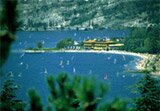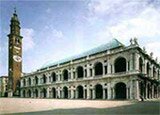|
|
 |
|
|
|
|
| |
|
| |
 |
| |
| |
|
|
|
|
| The city of Verona |
|
|
Verona is the city of Shakespeare’s Romeo and Juliet, a city famous worldwide for its magnificent historical buildings, squares, streets and bridges over the Adige River, the Opera Festival, the nearby attractive resorts of Lake Garda. A city of unique beauty, witness to thousands of years of history, Verona is a modern business and trade centre. Its historic centre has a typical Roman layout and Medieval, Renaissance, Venetian and Austrian buildings are all around the town. The city is busy with a harmonious blend of culture and business, history and modernity, efficiency and cordiality.
Located about 110km west of Venice and 160km east of Milan, Verona is well connected with other Italian and European cities by major highways and railways, as well as by the Verona “Catullo” International Airport. Its easy-to-reach location, the beauty of the surroundings, the high standard of hotel accommodation, food, wine, facilities and services, make Verona the ideal place for meetings, conferences and congresses.
|
| |
| The Arena |
| |
|
Sumptuous theatre in the evening, the Arena is the symbol of the city's Roman tradition, concluded by about 30. a.D..
During the Roman era in the amphitheatre were the sought after fights between gladiators and those of men against beasts.
This monument is formed of four concentric rings, the outermost today retaining only the four archways of the wing (ala).
The second ring followed, which today is seen as the exterior of the Arena. Inside, the actual space of amphitheatre is the result of restoration work carried out between 1569 and 1680, under the Venetian Republic. At that time, the amphitheatre return to more entertaining functions, and it was given over to bull-baiting and plays and to an ever-widening panorama of the performing arts including, after 1856, classical opera, which has become the characteristic of the Arena in our times.
|
|
|
| |
|
| Juliet’s house |
| |
|
The Juliet's house with his famous balcony, in via Cappello 23, is a destination for tourists from all over the world.
The courtyard receives the Juliet's bronze sculpture created by the Veronese Nereo Costantini.
The interior of the medieval house is an faithfully recreated ambience in 14th century style and is enriched by an interesting exposition of Medieval ceramics.
Shakespeare's tragic love story of two unhappy Veronese joung lovers, Juliet and Romeo and the rivalry between Montecchi and Capuleti families is recorded also by the poetry Dante in the 1300. It remain suspended the question if Juliet really lived in this house...
|
|
 |
|
| |
| Getting around in the city centre |
| |
By car: Via Roma, via Mazzini, via Cappello, via Leoni and Corso Portoni Corsari are all pedestrian zones. The historical centre is closed to traffic, with the exception of residents, authorised vehicles and cars going directly to hotels. Free parking are available in the surrounding area but only for one hour with parking disc or in multi-level car parks (parking fees charged) beside Piazza Bra.
Car parks
- Telephone
- Telephone
- Telephone
- Telephone
By bus: city buses are orange color and marked AMT; tickets must be bought before getting on the bus in the tobacconist and from newspaper shops. A daily ticket is also available.
By taxi: Taxi don’t stop on the street. You will find taxi stands at the railway station and in the city centre in Piazza Bra. Radiotaxi (24 hours a day) phone: - Piazza Bra phone: - Railway Station Verona Porta Nuova phone:
|
| |
| Verona and its surrounding |
| |
|
Located in the Veneto Region, in the North-East of Italy, Verona is at the crossroads of the main thoroughfares linking Central Europe to the Mediterranean area and Eastern to Western Europe. The territory surrounding Verona is dominated by the River Adige (gracefully braiding its way through the city with gentle curves) and the low undulating foothills that ramble off into the horizon. To the north of the city, the sweep of the river valley and the pre-Alpine climate combine to create an impressive mountainous landscape that continues all the way to the spectacular Dolomite mountains. To the south, by contrast, extends the great Po Valley, a flat expanse as far as the eye can see, repeatedly cut by the massive sway of the River Po (Italy’s longest and most famous river).
|
| |
 |
|
A few kilometres from Verona sits Lake Garda, Italy’s largest and deepest lake. Lake Garda’s wonderfully temperate climate and typically Mediterranean flora have long made it the preferred playground of locals and the savoured summer destination of tourists from all over the world. The thermal facilities of the nice village of Sirmione represent another important tourist attraction.
|
|
| |
 |
|
Besides Verona and its beautiful surroundings, Veneto Region is also proud of its great cities of art and culture: Vicenza and the villas of Andrea Palladio, Padova and the frescoes of Giotto, Treviso with Canova and, of course, Venice. Add to the mix, the countless charming ancient towns that dot the region (Asolo, Castelfranco Veneto, Marostica, Bassano del Grappa, Este) make Veneto a place not to be missed by any visitor to Italy.
|
|
| |
|
|
| |
|
|
|
| |
 |
|
| |
|
|
|